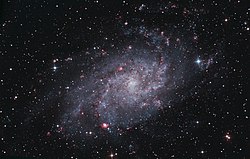Triangulum Galaxy
| Triangulum Galaxy | |
|---|---|

Triangulum Galaxy – Messier 33
|
|
| Observation data (J2000 epoch) | |
| Pronunciation | /traɪˈæŋɡjᵿləm/ |
| Constellation | Triangulum |
| Right ascension | 01h 33m 50.02s |
| Declination | +30° 39′ 36.7″ |
| Redshift | -0.000607 ± 0.000010 |
| Helio radial velocity | -179 ± 3 km/s |
| Galactocentric velocity | -44 ± 6 km/s |
| Distance | 2.38 to 3.07 Mly (730 to 940 kpc) |
| Apparent magnitude (V) | 5.72 |
| Characteristics | |
| Type | SA(s)cd |
| Mass | 5 × 1010M☉ |
| Number of stars | 40 billion (4×1010) |
| Size | ~60,000 ly (diameter) |
| Apparent size (V) | 70.8 × 41.7 moa |
| Other designations | |
| NGC 0598, MCG+05-04-069, UGC 1117, PGC 5818 | |
The Triangulum Galaxy is a spiral galaxy approximately 3 million light-years (ly) from Earth in the constellation Triangulum. It is catalogued as Messier 33 or NGC 598, and is sometimes informally referred to as the Pinwheel Galaxy, a nickname it shares with Messier 101. The Triangulum Galaxy is the third-largest member of the Local Group of galaxies, behind the Milky Way and the Andromeda Galaxy. It is one of the most distant permanent objects that can be viewed with the naked eye.
The galaxy is the smallest spiral galaxy in the Local Group and it is believed to be a satellite of the Andromeda Galaxy due to their interactions, velocities and proximity to one another in the night sky. It also has an H-II nucleus.
The galaxy gets its name from the constellation Triangulum, which is where it can be spotted.
The Triangulum Galaxy is sometimes informally referred to as the "Pinwheel Galaxy" by some amateur astronomy references and in some public outreach websites. However, the SIMBAD Astronomical Database, a professional astronomy database that contains formal designations for astronomical objects, indicates that the name Pinwheel Galaxy is used to refer to Messier 101, and several other amateur astronomy resources and other public outreach websites also identify Messier 101 by that name.
Under exceptionally good viewing conditions with no light pollution, the Triangulum Galaxy can be seen with the naked eye. It is one of the most distant permanent objects that can be viewed without the aid of a telescope. Being a diffuse object, its visibility is strongly affected by small amounts of light pollution. It ranges from easily visible by direct vision in dark skies to a difficult averted vision object in rural or suburban skies. For this reason, Triangulum is one of the critical sky marks of the Bortle Dark-Sky Scale.
...
Wikipedia
